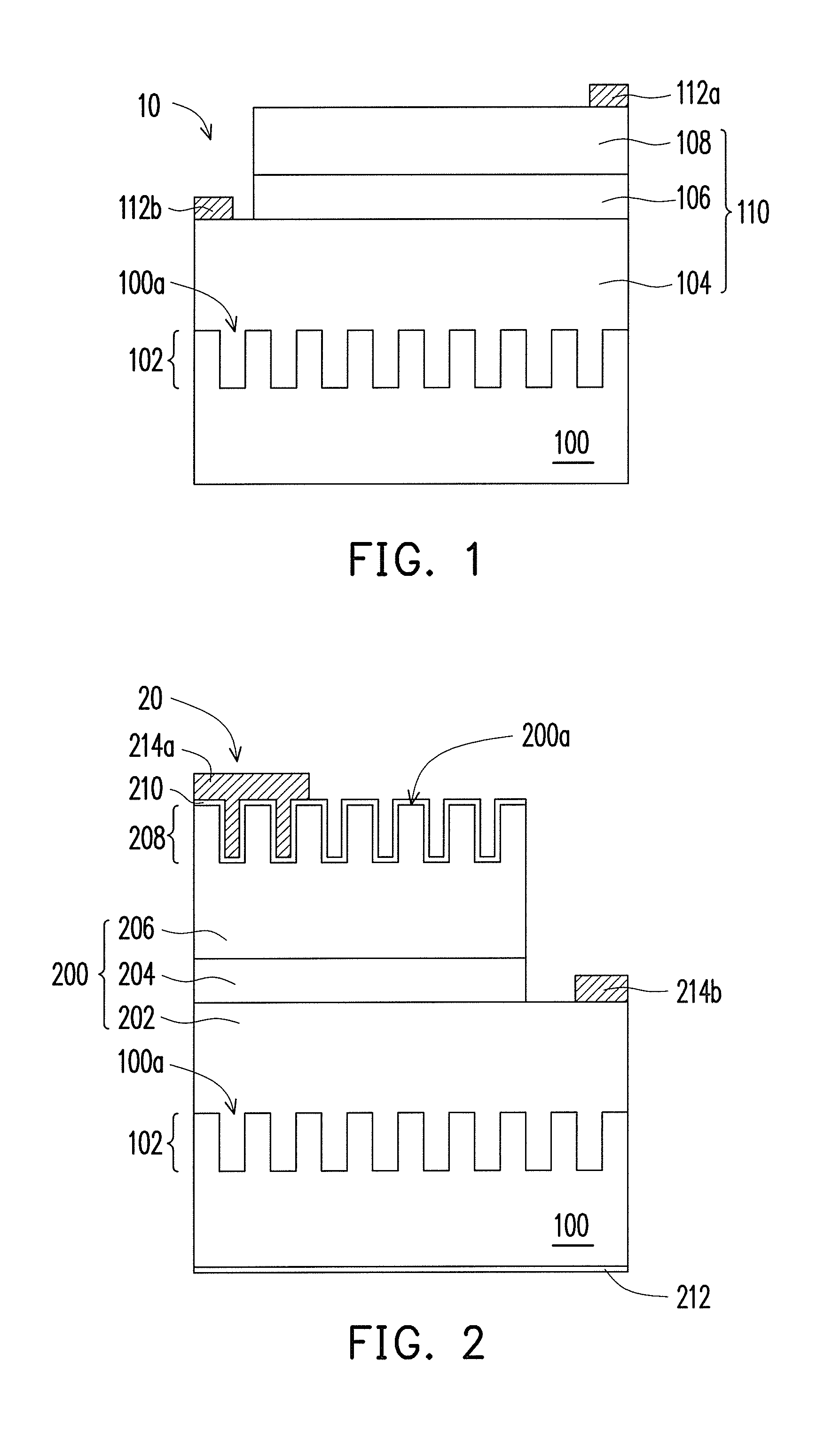Solar cell and method of manufacturing the same
a solar cell and photoelectric technology, applied in the field of solar cells, can solve the problems of increasing social costs, air pollution and environmental damage, and the shortage of fossil fuel supply, and achieve the effect of enhancing the photoelectric performance of solar cells
- Summary
- Abstract
- Description
- Claims
- Application Information
AI Technical Summary
Benefits of technology
Problems solved by technology
Method used
Image
Examples
first embodiment
[0031]A schematic diagram of a solar cell of the present invention is shown in FIG. 1. The solar cell is group III-V compound solar cell, for example. FIG. 1 shows a lateral view of the solar cell 10, which includes a substrate 100 having a surface 100a with photonic crystals 102, a multilayer semiconductor layer 110, a first electrode 112a and a second electrode 112b. The substrate 100 includes sapphire, GaAs, Ge, Si, SiGe or the other materials, for example. The multilayer semiconductor layer 110 is disposed on the surface 100a of the substrate 100, and the first electrode 112a and the second electrode 112b are respectively disposed on different conduction-type portions of the multilayer semiconductor layer 110. For example, an arrangement of the photonic crystals 102 includes periodic, quasi-periodic or non-periodic arrangement, in which the periodic arrangement may include four-fold rotational symmetry or six-fold rotational symmetry. Moreover, the photonic crystals 102 may be p...
second embodiment
[0033]For further explanation, a schematic diagram of a solar cell of the present invention is shown in FIG. 2. FIG. 2 shows a solar cell 20 similar to that in FIG. 1, and the same numbers represent the same elements in FIGS. 1 and 2. The solar cell 20 includes a substrate 100 having a surface 100a with photonic crystals 102 and a multilayer semiconductor layer 200, wherein the multilayer semiconductor layer 200 has a top surface 200a with other photonic crystals 208. In addition, an arrangement of the photonic crystals 208 includes periodic, quasi-periodic or non-periodic arrangement, in which the periodic arrangement may include four-fold rotational symmetry or six-fold rotational symmetry. Moreover, the photonic crystals 208 may be produced by Laser interferometric lithography, electron beam lithography or Nanoimprint. When a light is incident to the solar cell 20 from the top surface 200a with first kind photonic crystal 102 functioned as surface texture surface, the light may e...
third embodiment
[0035]A schematic diagram of a GaN-based solar cell of the present invention is shown in FIG. 3. FIG. 3 shows a GaN-based solar cell 30 that includes a first electrode 300, a second electrode 310, and a multilayer semiconductor layer 320 having at least one active layer 324, wherein a material of the multilayer semiconductor layer 320 is a GaN-based semiconductor or alloy thereof, such as GaN, InN, AlN, InGaN, AlGaN, AlInGaN and so on. In FIG. 3, the multilayer semiconductor layer 320 includes a first conductive type semiconductor 322, the active layer 324, and a second conductive type semiconductor 326, for example. The first electrode 300 is disposed on a surface of the first conductive type semiconductor 322, and the second electrode 310 is disposed on a surface of the second conductive type semiconductor 326 opposite to the first electrode 300. Furthermore, the multilayer semiconductor layer 320 includes a p-n or a p-i-n structure. A type of the first electrode 300 and the secon...
PUM
 Login to View More
Login to View More Abstract
Description
Claims
Application Information
 Login to View More
Login to View More - R&D
- Intellectual Property
- Life Sciences
- Materials
- Tech Scout
- Unparalleled Data Quality
- Higher Quality Content
- 60% Fewer Hallucinations
Browse by: Latest US Patents, China's latest patents, Technical Efficacy Thesaurus, Application Domain, Technology Topic, Popular Technical Reports.
© 2025 PatSnap. All rights reserved.Legal|Privacy policy|Modern Slavery Act Transparency Statement|Sitemap|About US| Contact US: help@patsnap.com



